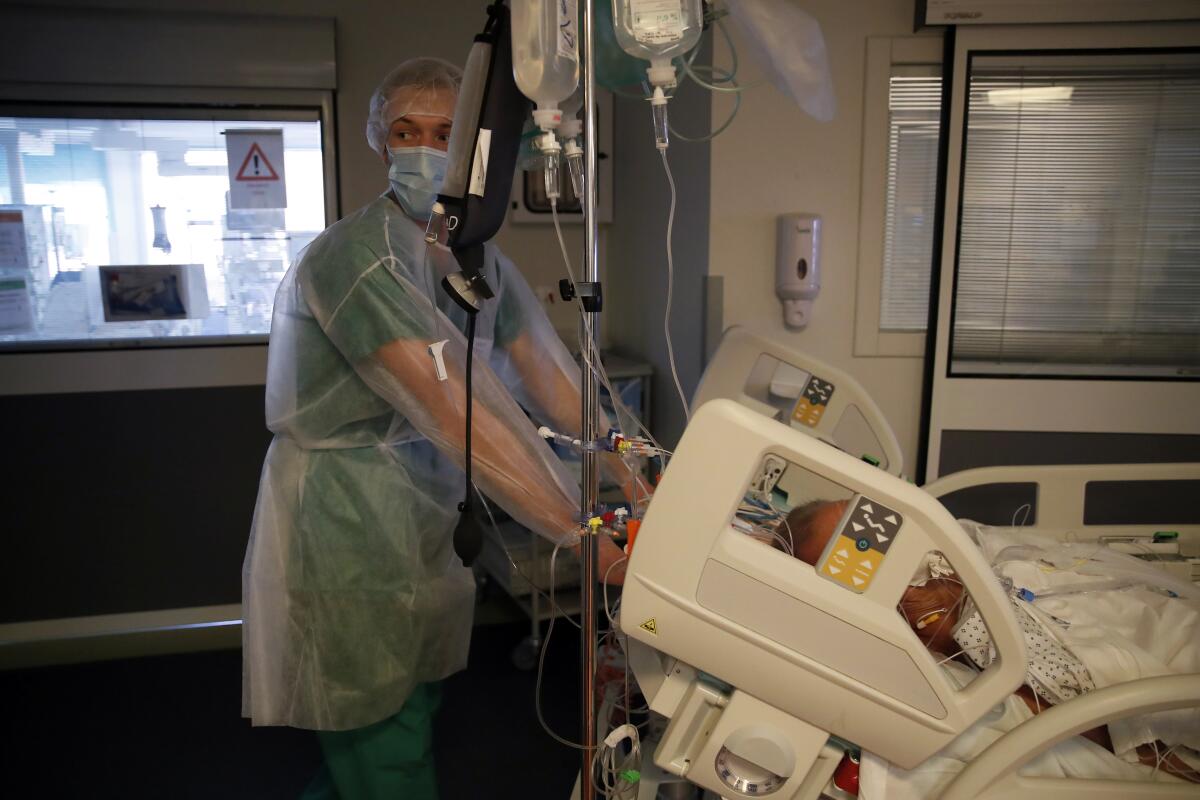Hospital workers despair as France’s coronavirus strategy flails

- Share via
AMIENS, France — As France battles a new virus surge that many believe was avoidable, intensive care aide Stephanie Sannier manages her stress and sorrow by climbing into her car after a 12-hour shift, blasting music and singing as loud as she can.
“It allows me to breathe,” she says, “and to cry.”
People with COVID-19 occupy all the beds in her ICU ward in President Emmanuel Macron’s hometown hospital in the medieval northern city of Amiens. Three COVID patients have died in the last three days. The vast medical complex is turning away critically ill patients from nearby towns for lack of space.
With France now Europe’s latest virus danger zone, Macron on Wednesday ordered temporary school closures nationwide and new travel restrictions. But he resisted calls for a strict lockdown, instead sticking to his “third way” strategy that seeks a route between free movement and confinement to keep both infections and a restless populace under control until mass vaccinations are possible.
The French government has refused to acknowledge failure, and blames delayed vaccine deliveries and a disobedient public for soaring infections and overcrowded hospitals. Macron’s critics, in turn, blame arrogance at the highest levels. They say France’s leaders ignored warning signs and favored political and economic calculations over public health — and lives.
“We feel this wave coming very strongly,” said Romain Beal, a blood oxygen specialist at Amiens-Picardie Hospital. “We had families where we had the mother and her son die at the same time in two different ICU rooms here. It’s unbearable.”
The hospital’s doctors watched as the variant ravaging Britain over the winter jumped the English Channel and forged south across France. Just as in Britain, the variant is now driving ever-younger, ever-healthier patients into French emergency rooms and critical care wards. Amiens medics did their best to prepare, bringing in reinforcements and setting up a temporary ICU in a pediatric wing.
After Britain’s death toll shot higher in January and new variants slammed European countries from the Czech Republic to Portugal, France stuck to its third way.
French scientists’ projections — including from the government’s own virus advisory body — predicted trouble ahead. Charts in January and February from national research institute Inserm forecast climbing virus hospitalizations in March or April. Worried doctors urged preventive measures beyond those that were already in place — a 6 p.m. nationwide curfew and the closure of all restaurants and many other businesses.
Week after week, the government refused to impose a new lockdown, citing France’s stable infection and hospitalization rates. Ministers emphasized the importance of keeping the economy afloat and protecting the mental health of a populace worn down by a year of uncertainty. A relieved public granted Macron a boost in the polls.
But the virus wasn’t finished. In the last three weeks the nationwide infection rate has doubled, and Paris hospitals are bracing for what could be their worst battle yet, with ICU overcrowding forecast to surpass the levels seen when the pandemic first crashed over Europe.
Acknowledging the challenges, Macron on Wednesday announced a three-week nationwide school closure, a monthlong domestic travel ban and the creation of thousands of temporary ICU beds. Parliament approved the measures Thursday.
While other European countries imposed their third lockdowns in recent months, Macron said that by refusing to do so in France, “we gained precious days of liberty and weeks of schooling for our children, and we allowed hundreds of thousands of workers to keep their heads above water.”
At the same time, France has lost an additional 30,000 lives to COVID-19 already this year. It has also reported more novel coronavirus infections overall than any country in Europe, and it has one of the world’s highest COVID death tolls — 95,640 lives lost.
Macron’s refusal to order a lockdown frustrates people like Sarah Amhah, who was visiting her 67-year-old mother in the Amiens ICU.
“They’ve managed this badly all along,” she said, recalling government missteps a year ago around masks and tests and decrying logistical challenges around getting a vaccine for elderly relatives. While she’s still proud of France’s world-renowned healthcare system, she’s not proud of her government. “How can we trust them?”
Pollsters note growing public frustration in recent days with the government’s hesitancy to crack down, and the potential impact of Macron’s current decisions on next year’s presidential campaign.
Government officials argue that softer restrictions are more likely to be respected. Macron told his ministers that instead of lockdowns, he’s focusing on the “speed race” to get the French population vaccinated.
Yet officials from the World Health Organization on Thursday bemoaned the slow pace of vaccinations in European countries like France, saying they have been “unacceptably slow” and risk prolonging the pandemic.
Macron last week defended his decision not to confine the country on Jan. 29, a moment epidemiologists say could have been a turning point in France’s battle to prevent surge No. 3.
“There won’t be a mea culpa from me. I don’t have remorse and won’t acknowledge failure,” he said.
Instead of emulating European neighbors whose strategies appear to be bringing infections down, French officials dodge questions about the growing death toll by comparing their country to places where the situation is even worse.
At the Amiens ICU, things are already bad enough.
“We have the impression that the population is doing the opposite of what they should be doing,” said Sannier, the nurse’s aide. “And we have the feeling we are working for nothing.”
Intern Oussama Nanai acknowledged that the drumbeat of grim COVID numbers has left many people feeling numb, and he urged everyone to visit an ICU to put a human face to the figures.
“There are ups and downs every day.... Yesterday afternoon I couldn’t do it anymore. The patient in [Room] 52 died, and the patient in [Room] 54,” he said.
But sometimes their work pays off. “Two people who were in the most serious condition for 60 days left on their own two feet, and they sent us photos,” he said. “That boosts our morale and makes us realize that what we are doing is useful.”
Sylvie Corbet in Paris and Maria Cheng in London contributed to this report.
More to Read
Sign up for Essential California
The most important California stories and recommendations in your inbox every morning.
You may occasionally receive promotional content from the Los Angeles Times.










